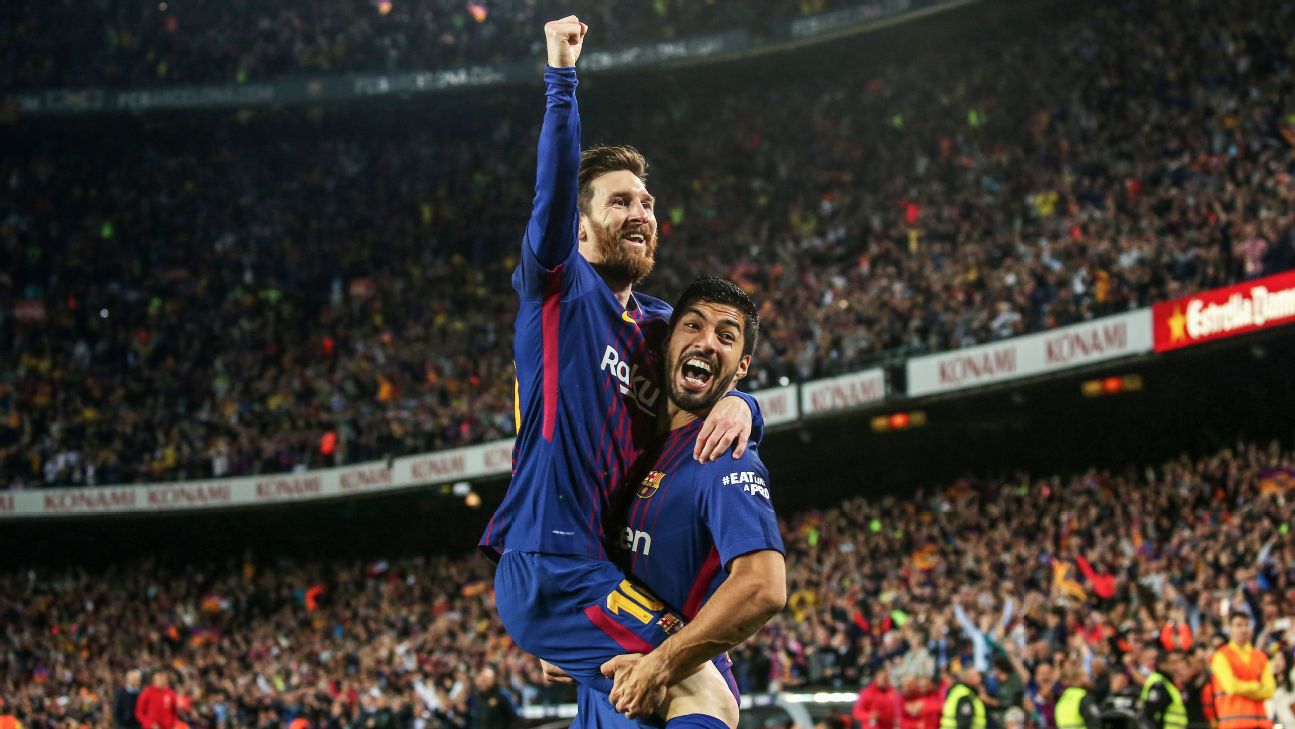Products You May Like



While they are kicking their heels rather than kicking a football, there is plenty of time for the two main members of the Barcelona attack to dwell on events of 15 years ago.
– Stream new episodes of ESPN FC Monday-Friday on ESPN+
- Stream every episode of 30 for 30: Soccer Stories on ESPN+
It was on May 1, 2005 that Lionel Messi scored his first goal for the club, lobbing the Albacete keeper with a wonderfully subtle touch. It was a deeply symbolic moment; Messi had latched on to a pass from Ronaldinho, who had taken the young Argentine under his protective wing. That pass was a footballing version of the relay baton passing from one to another. Within less than two years Ronaldinho would be on the downward slide, and Messi would be stepping into his boots as the club’s leading attraction.
There was already a murmur of expectation around Messi. At the start of the year, aged just 17, he had been outstanding for Argentina in the South American Under-20 Championships, staged in Colombia. Those who were there would not forget the uncanny way the ball was tied to his foot, his precocious vision of that was around him and capacity to make the right decision. That goal on May1st was the first senior moment in which his rich promise was confirmed.
Two days later, on May 3, 2005, came a massive milestone in the career of Messi’s future strike partner, Luis Suarez.
There were, as yet, no goals for the Uruguayan. But he did make his senior debut, coming off the bench for the last 15 minutes for Nacional of Montevideo in a crunch Copa Libertadores clash away to Colombian side Junior of Barranquilla. The 18-year-old Suarez had to fly from one end of the continent to the other to play a cameo role in a losing cause. Nacional had to win to make progress in the competition. Scores were level at 1-1 when Suarez was introduced. His thrust and skill down the right wing helped his team take the lead. But Junior hit back with two late goals, and Nacional crashed out of the competition.
There has been — so far at least — just one more opportunity for Suarez to win the Copa Libertadores. The following year, with the teenage striker starting to find his feet in the first team, Nacional made it out of the group phase only to fall in the second round to eventual champions Internacional of Brazil. Soon afterwards, after scoring 12 goals in 35 games, Suarez was gone, transferred across the Atlantic and on an ascending scale in European club football which would take him to Groningen and then Ajax in Holland, Liverpool in England, and, since 2014, Barcelona, where for six years he has dovetailed so well with Messi. The capacity of Suarez to work on the shoulder of the last defender has consistently pushed the opposition back and created space for Messi to work his magic — seen to best effect when Barcelona beat Juventus to win the 2015 Champions League.
The third member of the team’s strike force that day against Juve was Neymar, who unlike Messi and Suarez was adding the European title to the South American one he had already claimed when Santos won the Libertadores in 2011. But Neymar is something of an exception. He was a child prodigy who held out for some time — and was much criticized for so doing — before moving to Europe in 2013 at the age of 21, when he was already an established star.
The career paths of Messi and Suarez are more faithful reflections of the current reality. Messi moved to Spain at the age of 13, largely because his club in Argentina, Newell’s Old Boys, were unable to finance a hormone growing treatment. And Suarez was whisked quickly away, his club, a giant in Uruguay, unable to compete financially with a small club in Holland.
There is little sign of this trend being reversed. Neymar was something of a throwback. Not so long ago it was more common for South Americans to move to Europe only after they consolidated their careers — Romario and Gabriel Batistuta moved at the age of 22, but already had considerable professional baggage. Enzo Francescoli was 25. Bebeto, Romario’s strike partner, was 28.
These days the European clubs want them as young as possible; the transfer fee is lower, the sell-on value is higher and it is considered easier for the youngsters to adapt to faster, more compact top level European football. And it is likely that the European clubs will gain even more leverage. Their revenue streams are global. South American club football is more dependent on its local market, and, with economies still dependent on the production of raw materials, the region would seem to be in for a hard time in a post-pandemic world. The terms of trade may tip still further in favour of the European clubs.
Like Messi and Suarez, the next crop of South American superstars would seem much more likely to win the Champions League than the Copa Libertadores.
